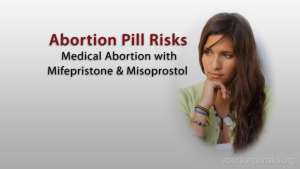Medical Abortion Video
Medical Abortion with Mifepristone and Misoprostol
Medical abortion is a non-surgical option for women who elect to terminate an early pregnancy. (1)
The FDA-approved regimen requires the combined use of two drugs: Mifepristone, commonly known as RU-486 or the Abortion Pill, followed 2 days later by oral Misoprostol; to terminate pregnancy up to 7 weeks gestation. (2)
Modified or alternate (alternative, off-label) regimens, often used by providers, are not approved by the FDA. (3)
Patients must be aware of the risks of serious complications, infection, and death. (4)
Mifepristone terminates pregnancy by blocking the action of progesterone. It acts on uterine blood vessels causing: vascular damage, bleeding, and embryo detachment. (5) (6)
Misoprostol completes the process by inducing: cervical dilation, bleeding, and uterine contractions to expel the embryo and placental tissue. (7) (8)
Surgical intervention may be required for failed abortion, excessive bleeding, or pregnancy tissue left in the uterus. (3) (9)
Infection and death have been reported in previously healthy women. (2) (10)
Infection may occur while the cervix is open during medical abortion allowing bacteria to contaminate the uterus. (11) (12)
Medical research suggests abortion drugs may impair or alter the immune response; responsible for deadly Clostridium sordellii infections. (11) (12) (13) (14) (15) (16)
Terminating an early pregnancy with mifepristone and misoprostol can be unpredictable.
Know the facts and risks of medical abortion.
References
1. Danco Laboratories, LLC. What is Mifeprex. Mifeprex (mifepristone tablets, 200 mg) the early option pill to end pregnancy. [Online] [Cited: June 15, 2011.] http://www.earlyoptionpill.com/what-is-mifeprex/.
2. U.S. Department of Health & Human Services. Drugs, Mifeprex (mifepristone) Information. FDA, U.S. Food and Drug Administration. [Online] July 19, 2011. [Cited: July 19, 2011.] http://www.fda.gov/drugs/drugsafety/postmarketdrugsafetyinformationforpatientsandproviders/ucm111323.htm.
3. U.S. Department of Health & Human Services. Drugs, Mifeprex Questions and Answers, 2/24/2010. FDA, U.S. Food and Drug Administration. [Online] February 24, 2010. [Cited: July 16, 2011.] http://www.fda.gov/Drugs/DrugSafety/PostmarketDrugSafetyInformationforPatientsandProviders/ucm111328.htm.
4. U.S. Department of Health & Human Services. Drugs, Labeling and Regulatory History from Drugs@FDA, Mifeprex (mifepristone) Medication Guide, Rev 3: 4/22/09. FDA, U.S. Food and Drug Administration. [Online] July 19, 2011. [Cited: July 20, 2011.] http://www.fda.gov/downloads/Drugs/DrugSafety/UCM088643.pdf.
5. Baulieu, E.E. and Ulmann, A. Antiprogesterone activity of RU 486 and its contragestive and other applications, Abstract. Human Reproduction, vol 1 (2): 107-110. [Online] 1986. [Cited: July 25, 2011.] http://humrep.oxfordjournals.org/content/1/2/107.abstract.
6. Spitz IM, Bardin CW. Clinical pharmacology of RU 486 – an antiprogestin and antiglucocorticoid. Contraception, Vol. 48, Issue 5. November 1993, pp. 403-444.
7. UCSF Center for Reproductive Health Research & Policy: San Francisco. Early Medical Abortion: Issues for Practice. Bixby Center for Global Reproductive Health. [Online] July 2001. [Cited: June 15, 2011.] http://bixbycenter.ucsf.edu/publications/files/EMAR.pdf.
8. Pfizer Inc. Cytotec labeling: Misoprostol tablets. Pfizer: Cytotec Physician Prescribing Information. [Online] September 2009. [Cited: June 15, 2011.] http://labeling.pfizer.com/ShowLabeling.aspx?id=559.
9. U.S.Department of Health & Human Services. Drugs@FDA, Label and Approval History, Mifepristone Labeling Revision. FDA, U.S. Food and Drug Administration. [Online] April 27, 2009. [Cited: July 16, 2011.] http://www.accessdata.fda.gov/drugsatfda_docs/label/2009/020687s015lbl.pdf.
10. Fischer, M, et al., et al. Fatal toxic shock syndrome associated with Clostridium sordellii after medical abortion, N Engl J Med;353:2352-60. New England Journal of Medicine. [Online] December 1, 2005. [Cited: July 20, 2011.] http://www.nejm.org/doi/pdf/10.1056/NEJMoa051620.
11. Miech, Ralph P. Disruption of the innate immune system by mifepristone and lethal toxin of Clostridium sordellii. Journal of Organ Dysfunction. 2007, pp. 1-5, i-First article.
12. Risks of mifepristone abortion in context. McGregor, JA and Equiles, O. November 2005, Contraception Journal, Volume 72, issue 5, p. 393.
13. Tait, A. Sasha, et al., et al. The Large Clostridial Toxins from Clostridium Sordellii and C. Difficile Repress Glucocorticoid Receptor Activity. Infection and Immunity, p. 3935-3940, Vol.75, No. 8. [Online] August 2007. [Cited: July 25, 2011.] http://iai.asm.org/cgi/content/short/75/8/3935.
14. Webster, Jeanette I and Sternberg, Esther M. Role of the hypothalmic-pituitary-adrenal axis, glucocorticoids and glucocorticoid receptors in toxic sequelae of exposure to bacterial and viral products. Journal of Endocrinology, 181, 207-221. [Online] May 2004. [Cited: July 25, 2011.] http://joe.endocrinology-journals.org/content/181/2/207.full.pdf.
15. Department of Health & Human Services, CDC, FDA, NIH. Emerging Clostridial Disease Workshop, May 11, 2006, James McGregor, pages 15-17. U.S. Department of Health & Human Services, U.S. Food and Drug Adminstration. [Online] June 22, 2006. [Cited: June 28, 2011.] http://www.fda.gov/downloads/AboutFDA/CentersOffices/CDER/UCM183030.pdf.
16. Aronoff, David M, et al., et al. Misoprostol Impairs Female Reproductive Tract Innate Immunity against Clostridium sordellii. The Journal of Immunology, vol 180, no 12, 8222-8230. [Online] June 15, 2008. [Cited: July 25, 2011.] l. http://www.jimmunol.org/content/180/12/8222.abstract.
Page Last Updated: 09/28/2011


Comments on this entry are closed.